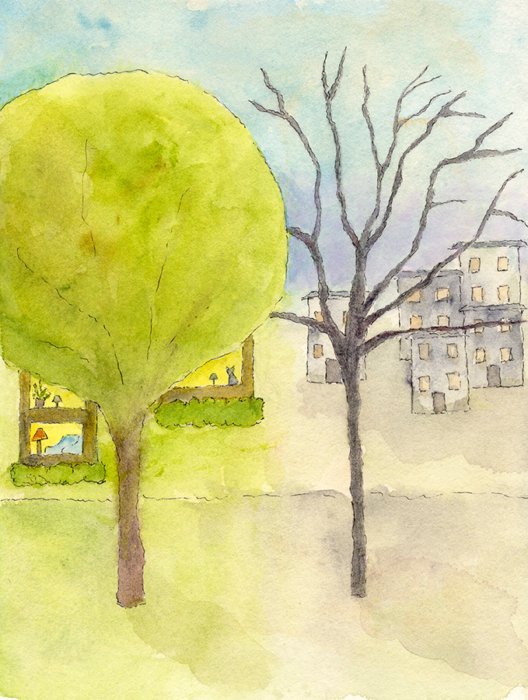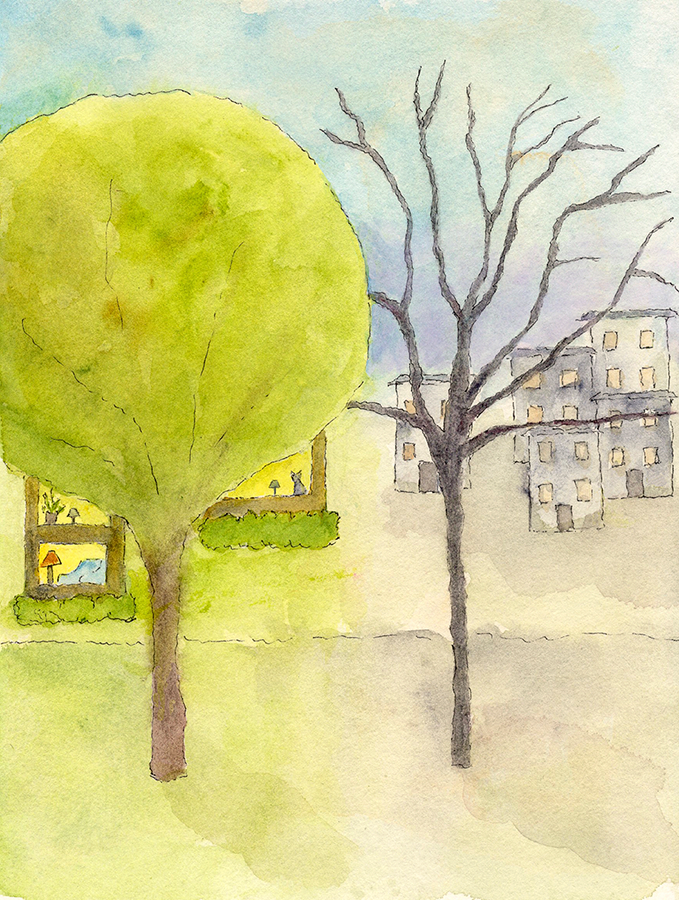
A third of the city-owned trees that line the streets, dot the parks, and shade the houses of Missoula, Montana, will likely be lost to old age in the next decade. Most of Missoula’s Norway maples, planted in the late 19th and early 20th centuries, are starting to reach the end of their life expectancy.
“When they start declining and showing their age, and the need for removals is starting, it’s hard,” said Jamie Kirby, urban forestry coordinator for the state of Montana. “The public is attached, and so are we, to the trees.”
Worst-case scenario, the city could lose 16,000 trees in the next 20 years. And Missoula isn’t alone. Stately trees are starting to die in older neighborhoods in cities across the region, from the lush Pacific Northwest to the Rocky Mountains to the prairie grasslands. That hurts the health and resiliency of urban forests, which are strongest when they’re a diverse mix of ages and types of trees.
U.S. Forest Service researchers found that urban tree cover nationwide is declining by about 175,000 acres — or 36 million trees — a year. Much of that decline comes as cities pave over greenspace, which means preserving existing trees is critical.
“No one wants to live in a city without trees,” said Karen Sippy, the executive director of the nonprofit Trees for Missoula. After all, urban trees tout a host of benefits. They absorb carbon dioxide and slow stormwater runoff. Trees boost property values, reduce air pollution, and cool urban environments in the summer, all at a relatively low cost. The city of Missoula values the annual socioeconomic benefit of its trees at $2.5 million.
“When you’re thinking about how much cooling you’re getting from those trees in the summer, how much you’re not having to run your AC, the benefits of that tree greatly outweigh that investment,” Marie Anderson, a forester with the city, said. “Our tree canopy is really what breaks up the giant heat island effect.”
But there’s the age problem. “As urban foresters, one of the things we’re always aware of is that we’re managing a living system,” said Kristin Ramstad, an urban forester with the Oregon Department of Forestry. “When you see a forest that has a lot of dead trees, it’s perhaps indicative of the fact that there wasn’t management in the last few decades to begin to diversify the ages of the trees.”
Proactive, strategic replanting is often the key to stemming off a drastic change in urban tree growth. But many cities and homeowners haven’t been following this plan. “We just have this huge gap between young trees and mature trees,” said Tara Costanzo, community resource forester for the state of Wyoming. “There’s not really anything in between.”
States are taking action to remedy the situation, though. In Wyoming, grant-funded tree planting programs in Cheyenne, Laramie, and Powell seek to address the age disparity Costanzo highlights. The Idaho Department of Lands’ TreePlotter tool, a geospatial program with tree canopy data from 2017, helps homeowners prioritize replacing trees by age and condition. Cities such as Boise and Sandpoint offer free saplings for homeowners to plant between their yard and the street. If the homeowner shepherds the tree through its first few years, the city will take care of the tree for the rest of its life.
Better understanding a city’s canopy is the first step to ensuring its health. Portland inventoried most of its 220,000 street trees between 2010 and 2015 and learned that, like other cities around the West, low-income areas and communities of color are less likely to have tree canopy in their neighborhoods (numerous studies have highlighted this trend nationwide). Meanwhile, historic and affluent neighborhoods had an oversupply of mature trees that will need to be replaced in the coming years.
A mile-and-a-half stretch of the Ainsworth Avenue median in northeast Portland is a prime example. Norway maples line the street. The trees were all planted at the same time, and they are now dying from old age at the same time; seven were cut down for public safety this year alone.
The problem stems from the fact that many urban areas have imagined “stately boulevards” in just one way for a long time, said Katie Lompa, a community assistance forester for the state of Oregon. “As a society, we tend to have trends in everything, and trees are also part of that trend.”
Washington’s Urban and Community Forestry Program manager, Linden Lampman, sees aging trees as an opportunity to change historical norms. The popular trees in her state, like Siberian elms, black locusts, and Norway maples, were brought by white settlers, in some cases more than 100 years ago. But now, Lampman said, other “designer trees” can fit into urban areas in a way that’s friendlier to urban infrastructure.
“It’s an opportunity to replace some of the species that are overrepresented in the structure of the forest, to be able to put in some diverse species that are better adapted for the urban setting as it is now,” Lampman said.
After all, trees aren’t just dying of old age. Many urban environments are becoming more difficult for trees to survive in overall. Those planted near high-traffic intersections must contend with salt dumped on the street and pollution from idling cars. Plus, climate change is expected to increase stress on trees in cities and rural areas alike. Experts say the increasing severity of storms, which bombard mature trees with more intense wind and snowfall, means reforesting and protecting existing trees is critical.
Public awareness of the importance of age- and species-diverse urban forests is growing. In Portland, neighbors who’ve lived through multiple iterations of jointly-planted crabapple trees all dying at the same time are starting to learn from the past.
“Some of the original homeowners … remembered the original planting and removals, and the second planting, and the second removals,” said Jim Gersbach, an Oregon Department of Forestry spokesman. “They’re saying, ‘Wait a minute — maybe we need to do something a little bit differently.’”
In smaller towns, one hurdle can be making sure funding for the trees is seen as a priority. “Because they’re small communities … their roads, their water, their sewer, their schools — all of those are higher priorities,” said Lompa. But some communities are starting to phase out the preference for “gray” infrastructure like roads at the expense of the “green” infrastructure of trees as benefits of the latter become better known.
“There are all kinds of ways to actually utilize an urban forest for the good of the entire community,” Lompa said.
Missoula, with its geriatric tree problem, is figuring that out. Voters approved a $15 million open space bond in 2018, part of which will pay for 650 new trees to be planted in the next three years.

